My immediate reaction to Wes Anderson isn’t hatred, love, or even annoyance. It's jealousy. After scorn-filled years spent perceiving him as a threat to my personal identity, this is the unsophisticated truth. I am not jealous of the fact that his films exist, it’s not the envy of an artist to another’s success and popularity. Instead I’m jealous that I don’t belong to the group that’s thrilled and inspired by his work. I want Anderson’s anti-authority themed films to matter to me (an anti-authority themed person), in a significant, or at least delightful way, and I’m frustrated that they don’t. And though he has his critics, it feels lonely not to fall in love with Wes Anderson.
In his new film, Moonrise Kingdom, two kids, Sam (Jared Gilman) and Suzy (Kara Hayward) fall in love and run away in the summer of 1965. Sam is an orphan and a boy scout. Suzy is a redhead with blue eyeshadow. The adults in their respective lives chase after the two: Suzy’s parents (Francis McDormand and Bill Murray) and Sam’s scout master and town sheriff (Edward Norton and Bruce Willis). The young lovers do their best to evade capture and defend their romance on beautiful overly-crafted sets meant to look exactly like overly-crafted sets. Moonrise is an extremely good looking movie, and its mood is powerful and infectious, but for me it was never more than inspiration for new eyeshadow or the urge to more carefully coordinate the colors in my kitchen.
***
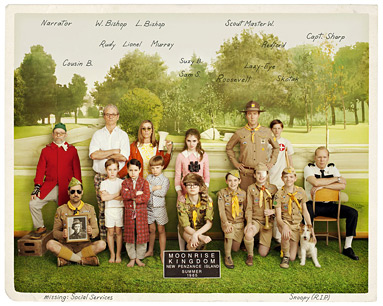
I do admire Anderson’s work for specific reasons: It is important any time a film with a consistent and instantly recognizable aesthetic reaches large audience. Like Nicolas Winding Refn's Drive, Anderson's work has particular value as gateway movies, appealing especially to teenagers (to which visible aesthetic is especially important). His visual consistency -- precisely because it is not intellectualized -- helps lead viewers into an awareness of the form itself, of what can be done in movies, and so the scope of our thinking begins to widen. As viewers, we begin to think of the plural “cinema” instead of the singular “movie.” Anything that helps to enlarge an understanding is important, as large thinking is contagious and will contaminate all other areas of your life, so that eventually nothing will be allowed to remain simple and small.
This is what art is supposed to do-- evoke a curiosity about ourselves, and the lives of others. But while Anderson begins this movement toward expansiveness, his films themselves encourage a too-precious, tongue-in-cheek view of life. Treating something as endearingly precious immediately denies it complexity. Anderson’s films appeal most to people who feel some degree of outsider-ness, looking in some small way for freedom. But because Anderson’s ideas and solutions are so simple and beautiful (i.e., “go ahead, feel like an outsider and do your own thing”) they reinforce a belief in simple contained worlds that allows people to remain untroubled by their lack of curiosity. His world is simple and exterior so the answers are simple and exterior as well. The preciousness of substance holds back the potential expansiveness of form.

In a New York Magazine interview from 2007, Anderson, in addressing criticism he’s received, said “When they say a movie I make is smarter-than-thou, that the movie is ‘too smart for its own good,’ as if we’re making movies to try to show everybody how great and cool we are…well, that’s just not the case. We’re trying our hardest to entertain people, to make something people will like, something people will connect with. I don’t think there’s a great effort to try to make some statement about ourselves, you know?”
It’s almost hard to believe that Anderson really believes this. Anyone who makes anything creative is making a statement about themselves. The difference is in how conscious the director/writer/artist is of their unconscious drive to figure themselves out through their work. Anderson is not simply trying to entertain people, he’s trying to do more, but this statement makes me suspect that he hasn’t given himself permission to be serious. Or maybe he just doesn’t really want to think about it. Either is frustrating.
He is fascinated with arrested spiritual and emotional development, and the pain and humor accompanying it, but he is not interested in the interior ideas behind it. The interior is large, the exterior is small. Anderson is charmed by smallness in content and form: small scale, small roles, small emotion, small stories, and he holds his films in a state of perpetual pubescence. He does this on two levels: Within the story itself (like children, his characters yearn for greater significance in the world), and, mirroring this, within the film's aesthetic (a kindergarten-esque extremely literal style contrary to grown-up ideas of sophistication).
This truncation of scope is why his films have always felt disappointing, but I'm wanting his work to be something it’s not, and in Anderson’s case, like Brecht or Godard, the form can’t be divorced from the substance. They are one and the same. Leading somewhere large would be contrary to his aesthetic, disrupting the consistency which I just praised.
The seamless blending of substance and form is the reason his films are good. But it's also the same reason they haven’t been more than good. For Anderson’s films to ever be great, the form and substance cannot be the same thing. I want him to look at smallness in a large way.
***
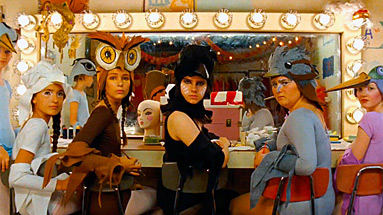
Nothing more perfectly evokes the feeling of both a child's literal interpretation of the world and youthful big ambition on a frustratingly small scale like a school play, and Anderson smartly adopts this style.
We don’t measure the success of a weird 6th grade production of “Who’s Afraid of Virginia Woolf,” for example, by its authenticity or the skill with which some kid recites. It’s worth lies solely in its sincerity of effort. This is how we connect emotionally with a school play and what we find endearing. We don’t lose ourselves in the emotion of the production, and for the same reason we’re not meant to lose ourselves in the story of an Anderson film. Like in a children’s play, we are meant to be aware at all times of creative effort, for this is where its true value lies. Anderson’s ability to blend substance and form and communicate this feeling is his greatest skill. His films look like a stage plays: Sets look like sets, the frame becomes the proscenium arch (with a symmetry in the set that exaggerates and enhances the frame's boundaries), and the action is kept in the center of the frame, usually directed out toward the audience in mainly medium or wide shots.
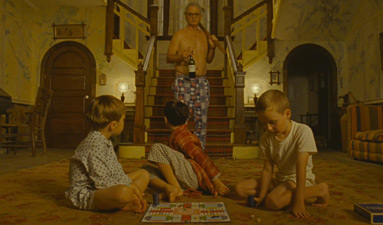
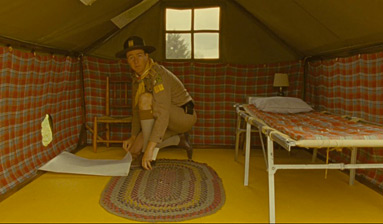
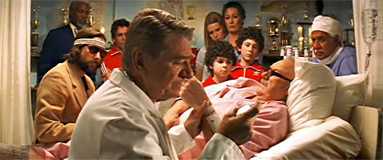
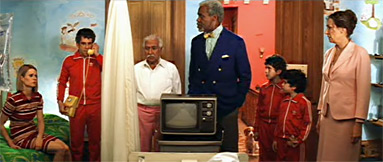
So when watching an Anderson film, as when watching an ambitious elementary school play, we’re always aware of human creative effort and will and it’s this effort and earnestness that makes the production significant, not the tradition of the play or the theatre. The satirization of the authority we’ve traditionally given established institutions and systems, such as the theater, is satirized: the family, marriage, school, police, the boy scouts, social services, and the church for example. Even maps, painted portraits, and signs and titles are portrayed with the corny and mythic aura we surround them with as children.
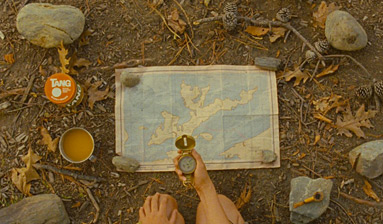
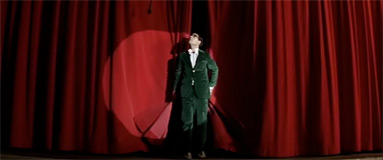
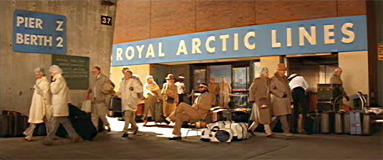
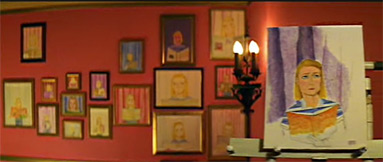
These combine to support what I see as Anderson’s main theme: The heroic rising of the weird individual's creative will under the oppressive weight of tradition and history. Break free and do your own thing.
It's a beautiful idea, and one I believe in, but as right as it is, it’s a notion usually born from a certain privilege (race, class, gender, and sexuality-wise), where will and effort can afford to be the most valuable thing. Any child of an immigrant mother will tell you that “good effort” does not fly, and remaining in a mental childhood for a second longer than necessary will get your face slapped.
***
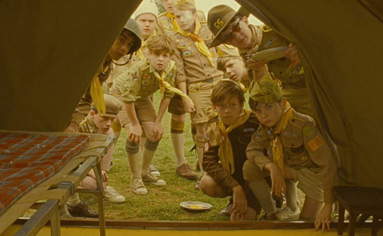
When I was 17, Wes Anderson became my number one enemy. In elementary school I experienced a great deal of racism. I was fat with a mushroom-esque haircut and to some children that’s a green light for racist motherfuckerness. In junior high I followed the predictable route from alternative (no longer exists), to punk and self-proclaimed anarchist. I dyed my hair, spiked it with Knox gelatin, drank many 40 ounces of Golden Anniversary, and became a part of a world that was entirely DIY. I organized a Women’s Radical Action Group chapter, volunteered at Food not Bombs, made my own zines, went to underground shows, and stopped caring at all about school. It was amazing. The punk scene of Worcester, Massachusetts was one of the most important things to happen to me. It changed the course of my life and through it I found a freedom I desperately needed at the time. Its message was the same simple lesson of all subcultures: it’s not just okay to be different, it’s better.
But it’s clear to me now that punk was also my attempt to take control of the otherness I’d been labeled with in school. If the world thought I was ugly and bad, it would be because I wanted to be. My mohawk was a protective and deflecting shield. Of course you don’t like me lady, but it’s because of my crazy hair and clothes, not who I am as a person. I would try to relocate the otherness from the interior to the exterior. But around 17, however, I began to feel alienated once more. I reluctantly realized I’d been denying a part of myself so as not to disrupt my new sense of belonging. I had found a new world where I mattered a little more, but it was still their world. Though deliberate contradictory weirdifying had been freeing for a time, underneath the outfit, and inside the flyered room, I was still brown, and the scene was mainly white. Though people weren’t deliberately racist, they also didn’t really want to or know how to talk about race.
This realization marked for me my identity as a person of color. I had always been one of course, but I’d gone from wishing I was white in elementary school, to ignoring race in high school, to finally accepting it as an important part of my identity. Exteriorization of otherness, wrongness, smallness, badness, though helpful for a moment, also discouraged me from examining the interior. It was easier and more attractive with more immediate benefits.
Around the same time The Royal Tenenbaums came out and everyone fell in love. I was furious. It was so easy for Anderson and his characters. They could exteriorize their outsiderness in simple ways, with dollhouse-like sets, rebelliously simplified camera movements, or oversized fur coats and orange winter hats.The world would worship him and them as a new cool heroes of non-conformity. Yes, Anderson was mildly anti-authority in a way that would have excited me at 13, but he was encouraging a simplistic and precious way of thinking that reinforced what 17 year old me was beginning to fight against. When your identity is built on the exteriorization of various feelings of outsiderness, it immediately gives you a sense of control in manipulating how the world interacts with you. So satisfying are these instances, that your visible exterior becomes a uniform that limits the desire to understand interior complexities and perhaps disrupt the new easy solution you've found. This perhaps is the comfortable place Anderson has found himself.
But for many people, feelings of inherent incorrectness in the world will never change without large thinking and an enormous shift in consciousness. This is why I want Wes Anderson’s films to be more expansive. He has the right idea, he just needs to take it further. Right now Anderson’s films hold valuable keys to life, but they only unlock doors for certain people. Great films touch on the universal, they hold keys for all.
